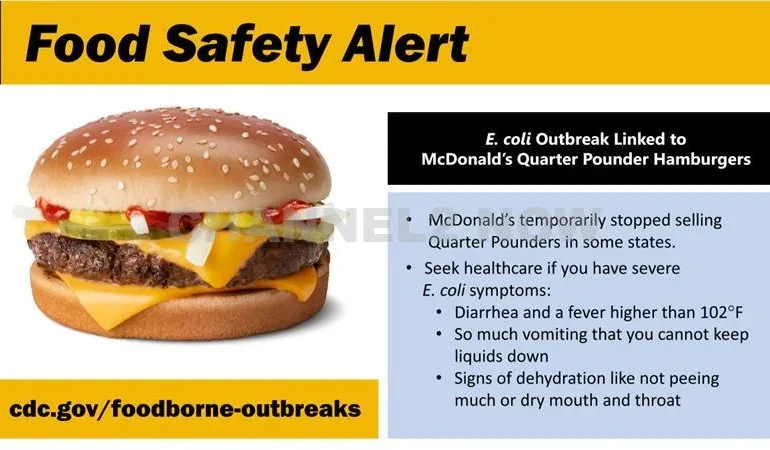Colorado Man Succumbs to Fatal E. Coli Outbreak Linked to McDonald’s Quarter Pounders, Leaving 10 Hospitalized and 49 Infected Across 10 States in Tragic Health Crisis”
The recent E. coli outbreak has escalated into a tragedy that claimed the life of a Colorado man and left ten others hospitalized, with 49 confirmed cases spanning across ten states. The Centers for Disease Control and Prevention (CDC) confirmed that the affected individuals had consumed McDonald’s products, primarily the iconic Quarter Pounder. The ongoing investigation by health officials has yet to pinpoint the exact source of contamination, though attention has been focused on the slivered onions and beef patty components, both of which have been withdrawn from McDonald’s locations in the impacted states. This development has not only triggered a swift response from federal and state authorities but also brought the food safety practices of one of the world’s most recognized fast-food chains under intense scrutiny.
The outbreak’s most severe concentration has been in Colorado, which accounts for 27 of the reported cases, followed by Nebraska with nine, and other states including Utah, Wyoming, Kansas, Missouri, Iowa, Wisconsin, Montana, and Oregon, each reporting cases linked to the same strain of E. coli. The death of the Colorado man, who had suffered from severe gastrointestinal symptoms, underscores the serious health risks associated with foodborne pathogens. The deceased was reportedly one of the earliest known patients in the outbreak, experiencing acute symptoms such as abdominal cramping, bloody diarrhea, and vomiting, which worsened to a life-threatening condition known as hemolytic uremic syndrome (HUS). This condition, a complication that occurs in severe E. coli infections, leads to kidney failure and is especially prevalent in vulnerable populations such as young children and the elderly. One child has already been hospitalized due to HUS, signaling the potential for further escalation.
Federal investigators have been working with McDonald’s suppliers and distribution networks to trace the origins of the contaminated products. Although preliminary tests have not yet identified a specific ingredient, the focus remains on the beef patties and slivered onions, commonly used in the Quarter Pounder preparation. Both items have been removed from circulation as a precautionary measure while further testing is conducted to prevent additional cases. The CDC and state health departments have issued advisories for those experiencing symptoms consistent with E. coli infection to seek medical attention immediately, especially if they had consumed food from McDonald’s in recent weeks.
E. coli bacteria are naturally present in the intestines of cattle, goats, sheep, and other animals, and while many strains are harmless, some can cause significant health risks when ingested through contaminated food or water. The strain responsible for this outbreak is known for its severe symptoms, including persistent stomach cramps, dehydration, and fever. As investigations continue, public health officials emphasize the importance of safe food handling practices both in commercial and household settings, as the risk of bacterial contamination can also occur during food preparation.
McDonald’s has issued a statement expressing condolences to the family of the deceased and a commitment to working closely with health authorities to resolve the situation. The company is also conducting internal reviews of its supply chain processes to identify any potential breaches in safety protocols. Meanwhile, legal experts anticipate potential lawsuits from those affected, as consumer protection laws entitle individuals to seek damages in cases of confirmed negligence leading to illness or death. The fast-food giant faces significant reputational challenges, as E. coli outbreaks associated with well-known brands can have lasting impacts on consumer trust.
Public health initiatives have also been ramped up, with advisories disseminated across news outlets and social media to raise awareness about the symptoms of E. coli infection and the importance of early medical intervention. With over 95,000 cases of E. coli reported annually in the United States, leading to significant morbidity and mortality, the outbreak serves as a stark reminder of the ongoing challenges in maintaining food safety standards on a large scale. The complexity of tracing foodborne illnesses often lies in the various points of contamination that can occur along the food supply chain, from farm to processing facilities, distribution, and finally to restaurants.
As health officials continue to investigate the outbreak, the incident raises broader questions about the effectiveness of current food safety regulations and the need for more stringent oversight of high-risk food items such as ground beef and fresh produce. Regulatory agencies may face pressure to implement more rigorous testing protocols, improve traceability measures in the supply chain, and enforce stricter standards for food handlers to reduce the risk of contamination. There is also a call for enhanced consumer education efforts to inform the public about safe cooking practices, such as thoroughly cooking meats and washing fresh produce, to minimize the risk of foodborne diseases.
The tragic death of the Colorado man, who had been a long-standing member of his local community, has also sparked a wave of condolences from friends and family, who described him as a kind-hearted individual who had a profound impact on those around him. His passing marks a somber chapter in the ongoing investigation and serves as a poignant reminder of the dangers associated with foodborne illnesses. Obituary notices have highlighted his contributions to the community and the deep void left by his untimely demise. In the wake of this tragedy, advocacy groups have renewed calls for stronger protections for consumers and better resources for rapid response to foodborne disease outbreaks.
The legal and medical communities continue to watch developments closely as further cases may emerge, given the extended incubation period of E. coli, which can range from one to ten days after exposure. Hospitals in the affected regions have been alerted to the outbreak, with medical professionals advised to report any suspected cases of E. coli infection. The evolving situation has spurred efforts to develop more rapid diagnostic tests to detect foodborne pathogens and prevent large-scale outbreaks in the future.
Ultimately, the ongoing investigation by the CDC and its partners may shed light on systemic issues within the food supply chain that have allowed this outbreak to occur. The results could lead to significant regulatory changes, including updated guidelines for fast-food safety protocols and more robust surveillance systems to detect and respond to foodborne illness outbreaks quickly. As the story continues to unfold, the impact on the fast-food industry, public health policy, and the affected communities remains significant.




